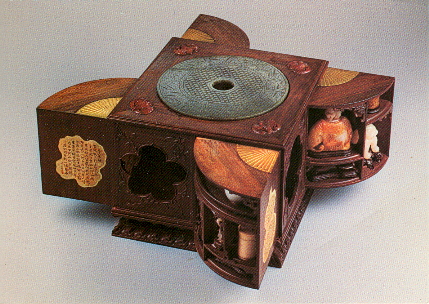When Revision Is Redesign: Key Questions for Digital Scholarship
Susan H. Delagrange
Inquiry
Q: How can guiding tropes or metaphors in a scholarly argument be embraced and embodied through the visual and navigation design of interactive digital media?
I have always been captivated by Wunderkammern, cabinets or entire rooms in which naturally occurring and man-made artifacts were collected, collated and catalogued. My fascination in them lies in their dual function as knowledge structure and as activity. As a knowledge structure, the choice and arrangement of artifacts in a Wunderkammer (which objects were collected and how they were situated in relation to one another) represents a view of the world. Are butterflies arranged by species? by size? by color? by geographical habitat? by medicinal property? Each arrangement is part of a different worldview, as is the presence or absence of butterflies in the first place. As an activity, adding and subtracting, arranging and re-arranging, are methods of inquiry and discovery that lead to new knowledge and also to the understanding that no single worldview is stable, or universal, or True. Wunderkammern and their contents are visible, tangible, fluid, and open to question and interpretation.
In short, the Wunderkammer serves as an ideal trope for the process of intellectual inquiry. And interactive electronic media constitute an ideal environment in which to design both the structure and activity of a digital Wunderkammer.

Chinese Treasure Box
Ch'ing Dynasty, Ch'ien-lung reign (1736-1795)
My goal, then, was to enact my argument—that the (visual) canon of arrangement, as represented in the Wunderkammer and further demonstrated in the assemblages of Joseph Cornell, is a heuristic for invention and discovery—by combining the visual effect of the Wunderkammer as a physical space with the embodied experiences of designing (for me) and exploring (for the viewer). In effect, a digital Wunderkammer would function as a thought engine in which the manipulation and arrangement of its contents by both collector/designer and visitor/viewer animates the process of inquiry and insight.
Wunder- kammern, enthusiastic collections of natural and man-made objects, are endlessly evocative of wonder. They speak to us of a sustained passion for imaginative discovery. They conjure up both broad obsession and meticulous attention to detail.
What, then, makes the experience of a Wunderkammer so provocative of wonder and discovery? I believe the answer lies in the fact that it is impossible to take in a Wunderkammer all at once. Even the small Chinese treasure box pictured above is astonishingly complex. About 10" square when closed, four compartments pivot open to reveal 30 objects of wood, metal, ivory, and jade in variously shaped and sized cubbyholes. The questions begin: Why these objects and not 30 others? What is their individual significance? How are they related to others in their compartment, others in the rest of the box? Who did they belong to? What were the circumstances of their coming together here? Was the box made for them, or were they collected for the box? To learn more, the visitor might remove the objects and examine them individually, or re-arrange them into new combinations. Each view, each new arrangement, is taken in and held up to the visitor's existing knowledge-map.
My revision/redesign started with the premise that the design experience must contain elements of building a Wunderkammer, and the viewer experience must contain elements of exploring one; I focused most closely on design environment, experience interface, movement, navigation, and ambiguity, as amplified on in the following sections. I have also included sections on production and code, as the question of whether and how to take on the role of designer in addition to that of author is one that new media scholars all confront.
